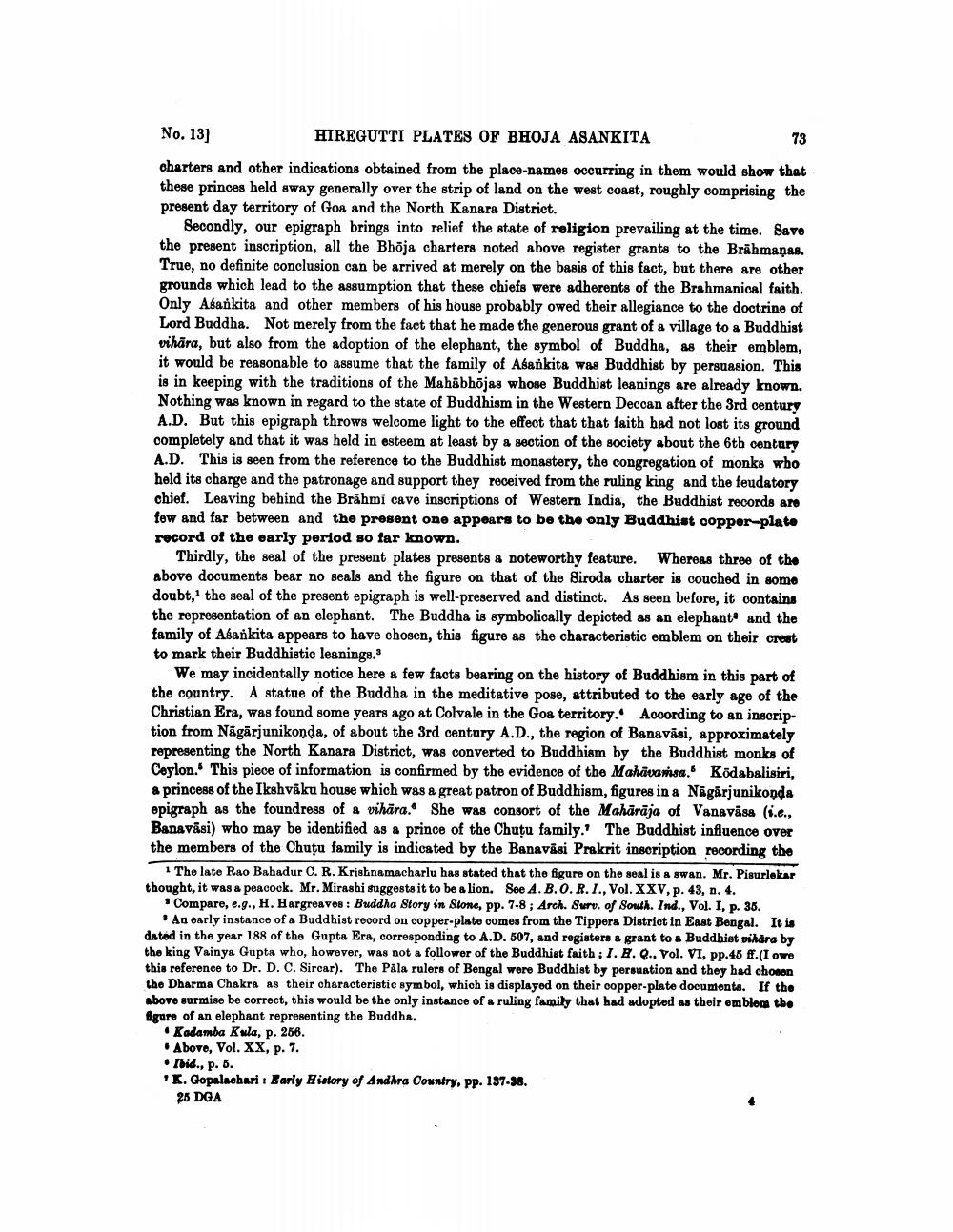________________
No. 13]
HIREGUTTI PLATES OF BHOJA ASANKITA charters and other indications obtained from the place names occurring in them would show that these princes held sway generally over the strip of land on the west coast, roughly comprising the present day territory of Goa and the North Kanara District.
Secondly, our epigraph brings into relief the state of religion prevailing at the time. Save the present inscription, all the Bhöja charters noted above register grants to the Brāhmanas. True, no definite conclusion can be arrived at merely on the basis of this fact, but there are other grounds which lead to the assumption that these chiefs were adherents of the Brahmanical faith. Only Asankita and other members of his house probably owed their allegiance to the doctrine of Lord Buddha. Not merely from the fact that he made the generous grant of a village to a Buddhist vihāra, but also from the adoption of the elephant, the symbol of Buddha, as their emblem, it would be reasonable to assume that the family of Asankita was Buddhist by persuasion. This is in keeping with the traditions of the Mahabhājas whose Buddhist leanings are already known. Nothing was known in regard to the state of Buddhism in the Western Deccan after the 3rd century A.D. But this epigraph throws welcome light to the effect that that faith bad not lost its ground completely and that it was held in esteem at least by a section of the society about the 6th century A.D. This is seen from the reference to the Buddhist monastery, the congregation of monks who held its charge and the patronage and support they received from the ruling king and the feudatory chief. Leaving behind the Brāhmi cave inscriptions of Western India, the Buddhist records are few and far between and the present one appears to be the only Buddhist oopper-plate record of the early period so far known.
Thirdly, the seal of the present plates presents & noteworthy feature. Whereas three of the above documents bear no seals and the figure on that of the Siroda charter is oouched in somo doubt, the seal of the present epigraph is well-preserved and distinct. As seen before, it contains the representation of an elephant. The Buddha is symbolically depicted as an elephants and the family of Abankita appears to have chosen, this figure as the characteristic emblem on their crest to mark their Buddhistic leanings.
We may incidentally notice here a few facts bearing on the history of Buddhism in this part of the country. A statue of the Buddha in the meditative pose, attributed to the early age of the Christian Era, was found some years ago at Colvale in the Gos territory. According to an inscription from Nagarjunikonda, of about the 3rd century A.D., the region of Banavāsi, approximately representing the North Kanara District, was converted to Buddhism by the Buddhist monks of Ceylon. This piece of information is confirmed by the evidence of the Mahavamsa. Ködabalisiri, a princess of the Ikshvāku house which was a great patron of Buddhism, figures in a Nāgārjunikonda epigraph as the foundress of a vihära. She was consort of the Maharaja of Vanavāsa i.e., Banavāsi) who may be identified as a prince of the Chutu family.' The Buddhist influence over the members of the Chutu family is indicated by the Banavāsi Prakrit inscription recording the
1 The late Rao Bahadur C. R. Krishnamacharlu has stated that the figure on the seal is a swan. Mr. Pisurlekar thought, it was a peacock. Mr. Mirashi suggests it to be a lion. See A.B.O.R.I., Vol. XXV, p. 43, n. 4.
Compare, e.g., H. Hargreaves: Buddha Story in Stone, pp. 7-8; Arch. Suru. of South Ind., Vol. I, p. 35.
An early instance of a Buddhist record on copper-plate comes from the Tippera District in East Bengal. It is dated in the year 188 of the Gupta Era, corresponding to A.D. 507, and registers & grant to a Buddhist vihara by the king Vainya Gupta who, however, was not a follower of the Buddhist faith; I. 8. Q., Vol. VI, pp.48 ff.(I owe this reference to Dr. D. C. Sircar). The Päla rulers of Bengal were Buddhist by persuation and they had chosen the Dharma Chakra as their characteristic symbol, which is displayed on their copper-plate documents. If the above surmise be correct, this would be the only instance of a ruling family that had adopted as their emblon the figure of an elephant representing the Buddha.
• Kadamba Kula, p. 266. . Above, Vol. XX, p. 7. • Ibid., p. 6. K. Gopalachari: Barly History of Andhra Country, pp. 137-38. 25 DGA




